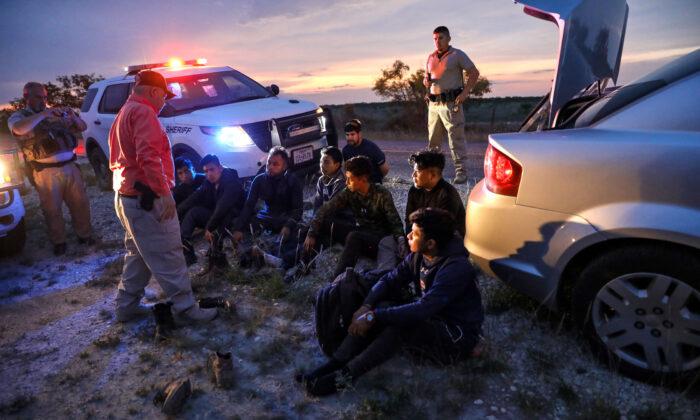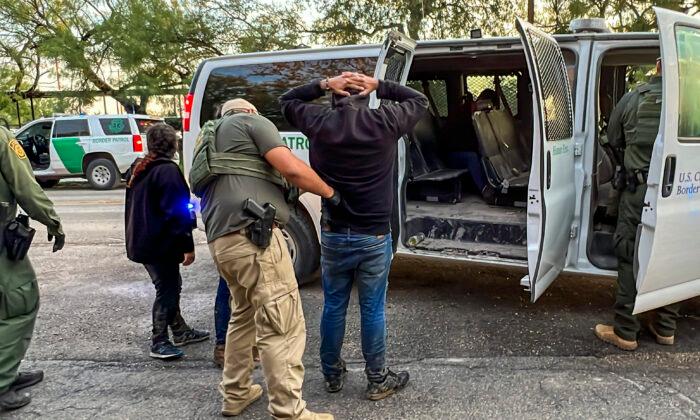One sheriff gets the illegal alien “gotaways” in his Arizona county, while the other predominantly gets the “give-ups.”
Cochise County Sheriff Mark Dannels said that during the month of March, his office apprehended more than 7,000 illegal immigrants who were trying to avoid capture, also known as “gotaways.”
Two years ago, that number was “a manageable” 400 per month, Dannels said.
Between 900 and 1,000 smugglers drive into Cochise County to pick up illegal aliens near the border and drive them to Phoenix for about $1,000 per head, according to Dannels.
“We need to understand that smuggling comes with criminal cartels. These transnational organizations, they have no respect for Americans, no respect for communities,” he said. “My office right now is investigating several acts here last month, where an agent—they tried to cut his throat. Had another one [where] they tried to kill the agent.”

As the Biden administration prepares to end the Title 42 public health order on May 23, border sheriffs are expecting the worst.
“We have great concern,” Dannels said. “It’s going to have a huge impact. We’re already outpaced.”
Title 42 is a Centers for Disease Control and Prevention order that was invoked in March 2020 under then-President Donald Trump to minimize the spread of COVID-19 by ensuring that only essential travel occurred at U.S. borders.
It directed that illegal immigrants could be quickly expelled back into Mexico as a pandemic precaution, rather than be processed under Title 8 immigration law, which is a much more protracted process inside the United States.
“Currently, we’re spending $17,000 a week out of a rural county sheriff’s office to address border security,” Dannels said.
Between July 1, 2021, and February, the sheriff’s office has spent $1.1 million in booking border-related criminals into the local jail.
The ‘Give-Ups’
A 320-mile drive to the west sits Yuma County, where Sheriff Leon Wilmot is grappling with thousands of illegal immigrants walking around the unfinished border wall and waiting for Border Patrol—the “give-ups.”“These are not poor people; they are dressed in designer clothing with money and cell phones,” Wilmot told The Epoch Times.
“They are flying into Mexico from over 140 different countries and then taking a cab or bus to the river. They walk across the border, discarding their trash, clothing, and identification [showing] they have been granted permission to live and work in Mexico. They are exploiting the weakness of this administration’s policies on our border.”

In 2021, Yuma Sector Border Patrol agents apprehended 183,750 illegal immigrants, according to Customs and Border Protection (CBP) data. In 2020, that number was 8,758.
“Estimates are that the cartels are making an average of $15 million a week in the smuggling of humans across the Yuma Sector alone,” Wilmot said. “This has led to escalated violence along the border in Mexico as the cartels fight over control of the border.”
He’s bracing for the end of Title 42 and expects border-related crime to increase.
“In my 37 years of law enforcement in Yuma County, I have never seen such a lack of border security or concern for the safety of our country as I do today,” Wilmot said.

In the Yuma Border Patrol Sector, agents are already so busy processing large groups of illegal aliens that only four agents are available to patrol a 150-mile section of the border.
“That 150 miles of border normally takes about 75 to 90 agents—we had four agents out there,” Brandon Judd, president of the National Border Patrol Council, said at an unofficial House hearing at FreedomWorks in Washington on Feb. 1. “Cartels control the border right now. They dictate to us what our operations are going to be. That should never happen.”
The amount of drugs being seized at the border has correspondingly plummeted, according to CBP data.
“If we seize even 5 percent of what’s coming across the border, we’re lucky,” Judd said, referring to a question about fentanyl pills. “And if there’s nobody there to detect you and apprehend you, the cartels are going to push it through between the ports of entry when they know that there is absolutely no chance that we’re going to apprehend that narcotic.”
The two Arizona Senators, both Democrats, wrote to President Joe Biden on March 24, urging him to keep Title 42 in place until the Department of Homeland Security (DHS) has a plan to handle the anticipated influx.
“To date, we have not yet seen evidence that DHS has developed and implemented a sufficient plan to maintain a humane and orderly process in the event of an end to Title 42,” Sens. Kyrsten Sinema (D-Ariz.) and Mark Kelly (D-Ariz.) wrote.

The agency would use “broadscale release mechanisms” such as issuing notices to appear in court or even releasing illegal immigrants without a court notice, a practice that wasn’t used until Biden took office, according to the document first published by Breitbart News.
As many as 450,000 illegal aliens could gather from the southern U.S. border through Central America in a 30-day period, according to one of the planning scenarios in the contingency plan. That could lead to “multiple surges” of 10,000 to 20,000 illegal crossings at different locations at the same time.
DHS, which already dealt with a record-level of illegal immigration during Biden’s first year in office, has stated that ways to remove illegal immigrants “will be limited” once Title 42 is revoked.
Rep. Andy Biggs (R-Ariz.) said the law doesn’t allow for the mass release of illegal aliens.
“The Department of Homeland Security must either enroll all illegal aliens in the Migrant Protection Protocol program or detain them as required by law,“ Biggs recently told The Epoch Times. ”Simply releasing them is unacceptable and illegal.”

Border Security vs Immigration
Former U.S. Border Patrol Chief Rodney Scott said border security and immigration need to be seen as two different entities.Scott, who was a Border Patrol agent for almost 30 years, retired from the top job last August and now works with the Texas Public Policy Foundation.
He said the ports of entry are similar to a front door in a home and that Congress has made it illegal to cross between ports of entry.
“It’s just like trying to enter through a window of your home, come through the side door or something like that, uninvited—regardless of who that person is, where they’re from, or what their intent is,” Scott said. “So the fundamental baseline part of border security, simply knowing who and what enters our home, is not being accomplished.
“There literally is no real enforcement of the law on the southwest border right now. Border Patrol agents have been relegated to being processing officers, administrative processing. And the border is just wide open—it’s ridiculous.”
Immigration includes the decisions Congress has made about who to grant visas, green cards, and citizenship to, as well as who to allow into the country and what type of vetting process they should undergo before entering.





